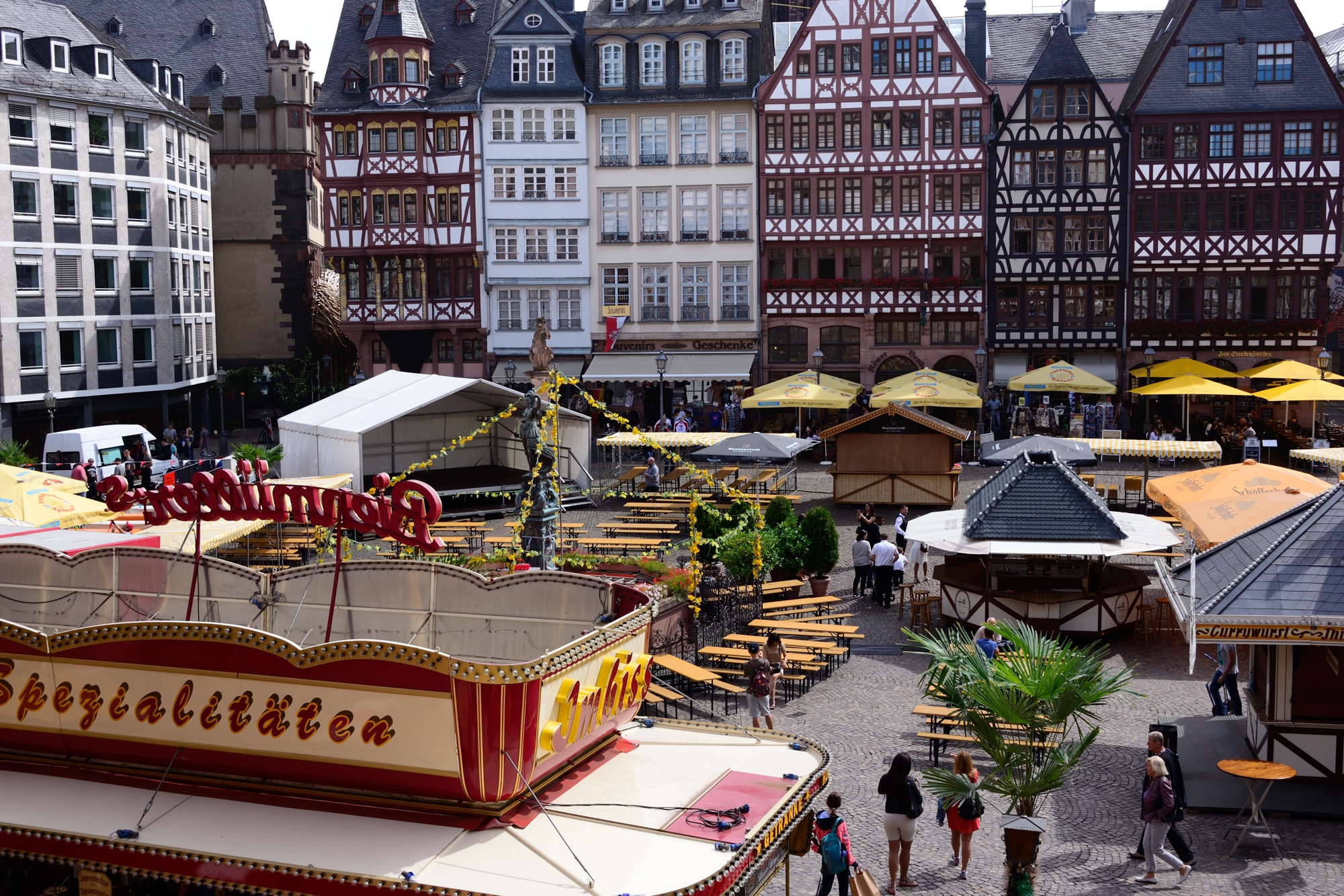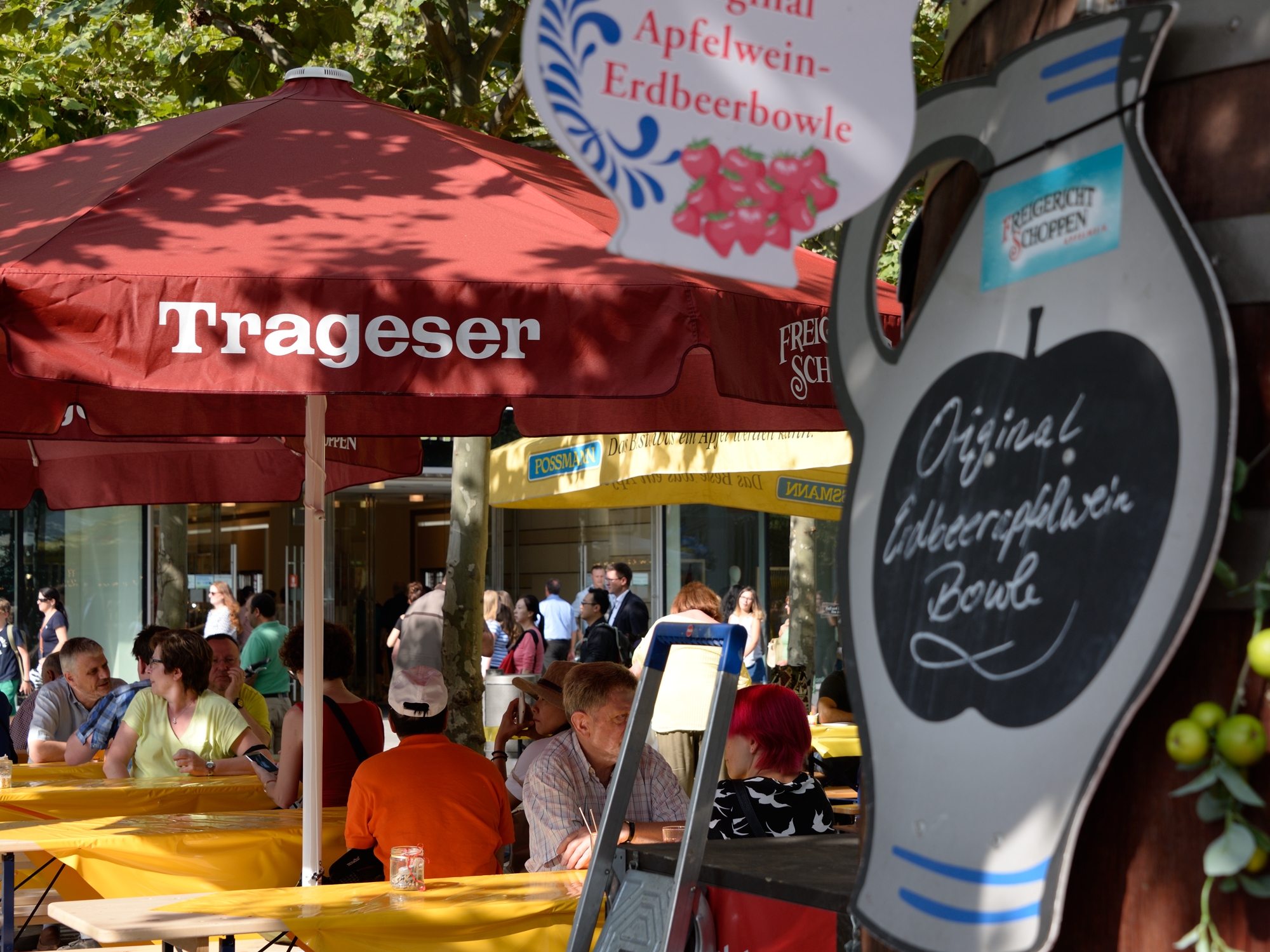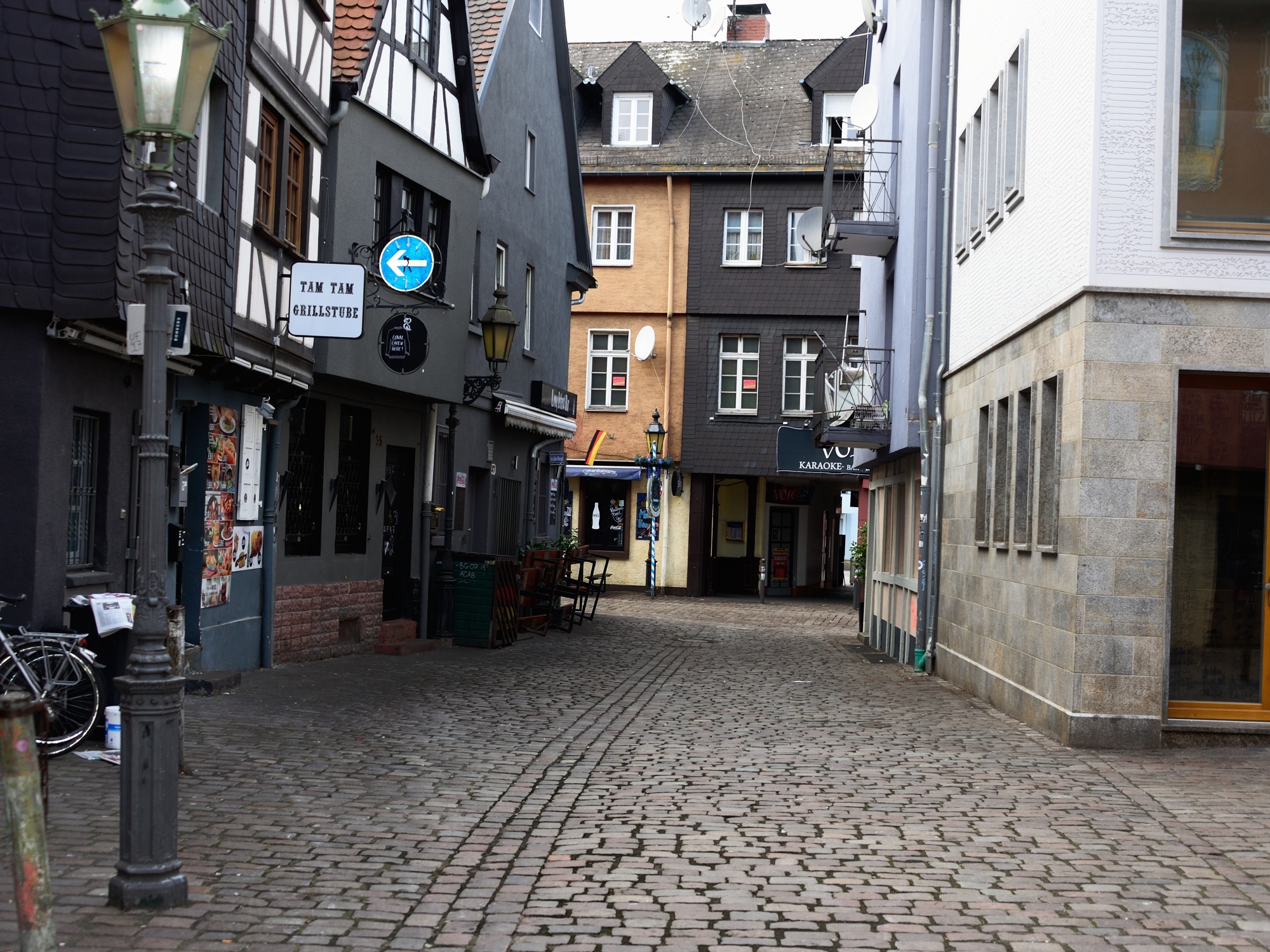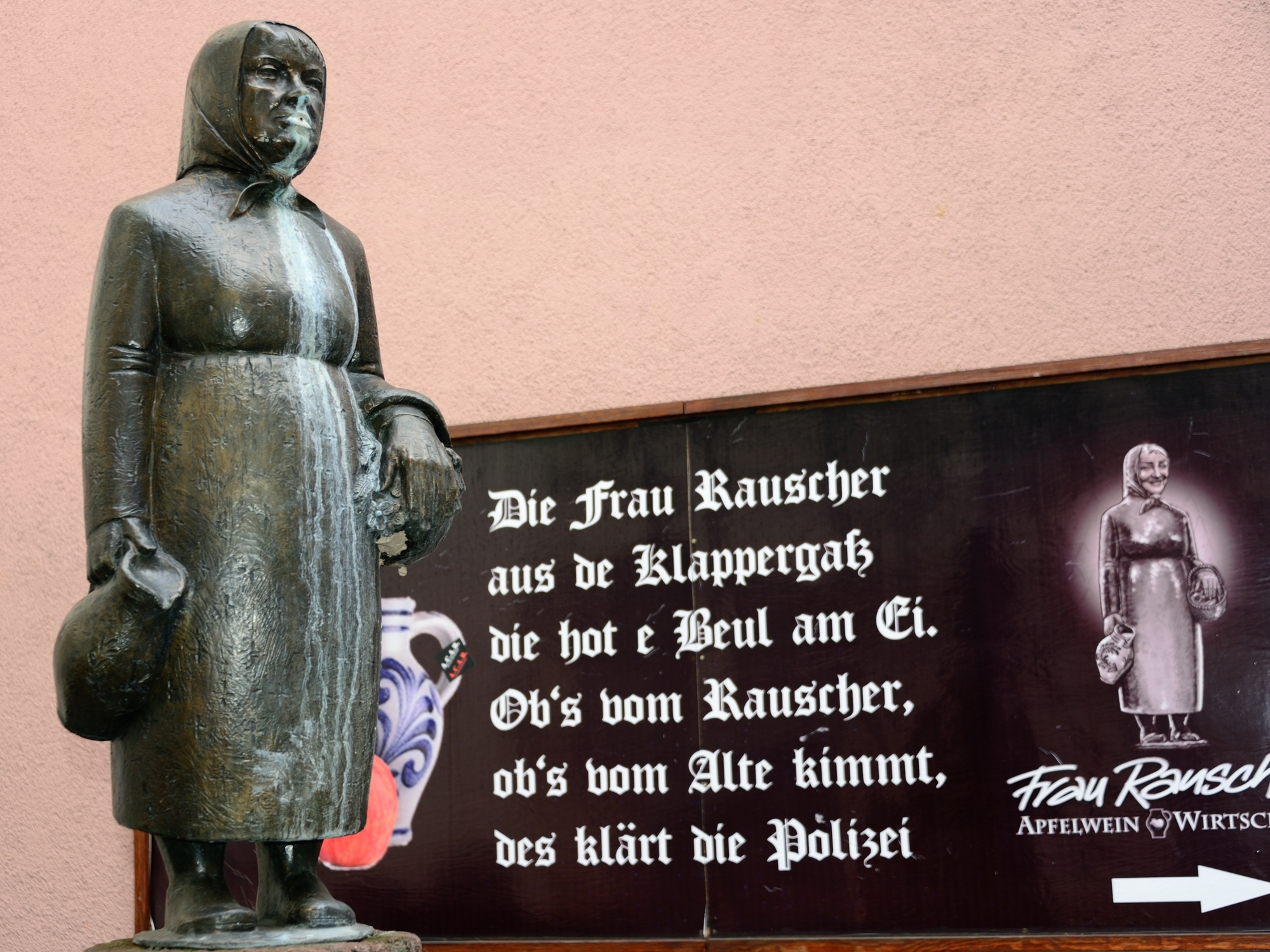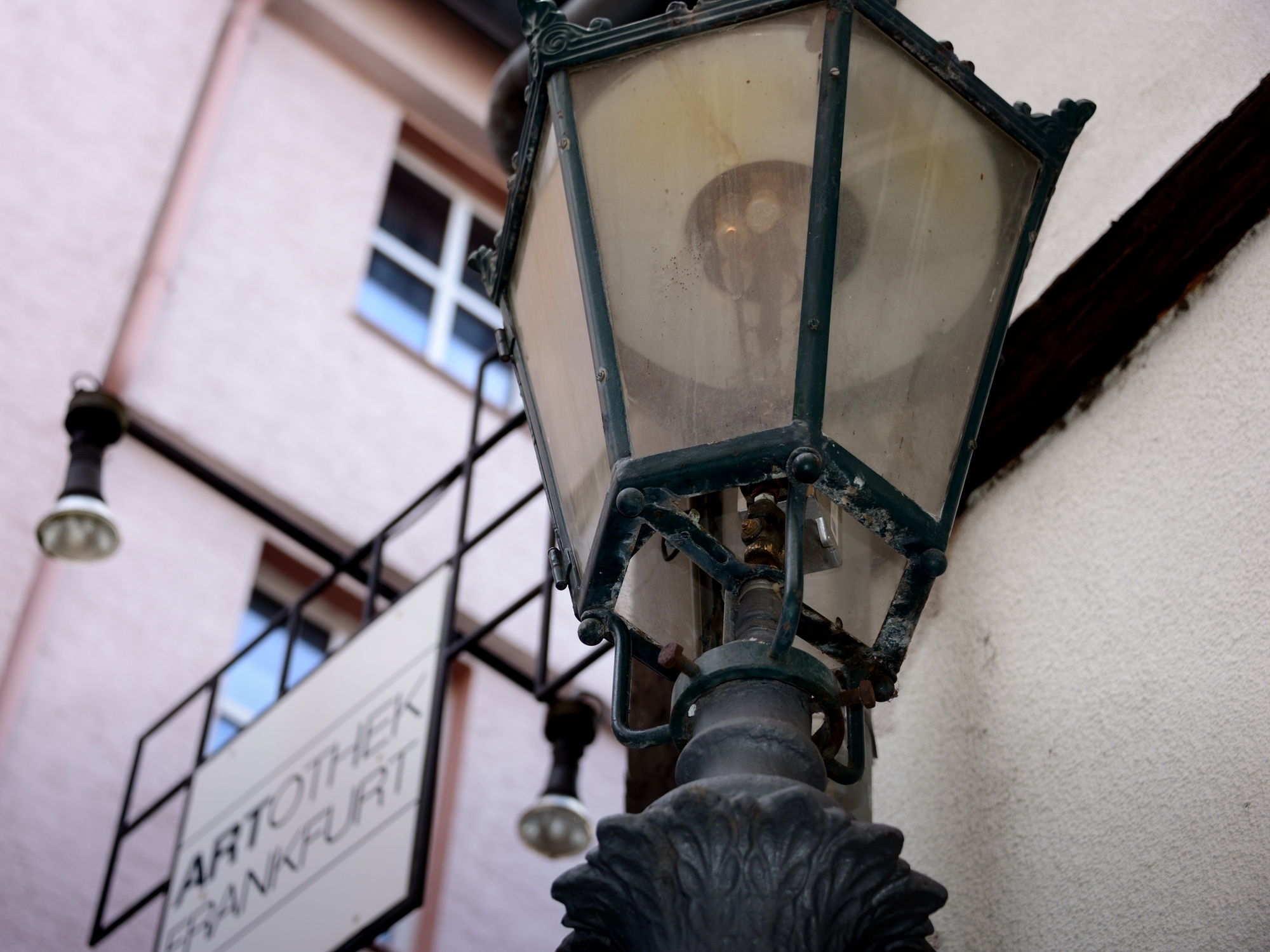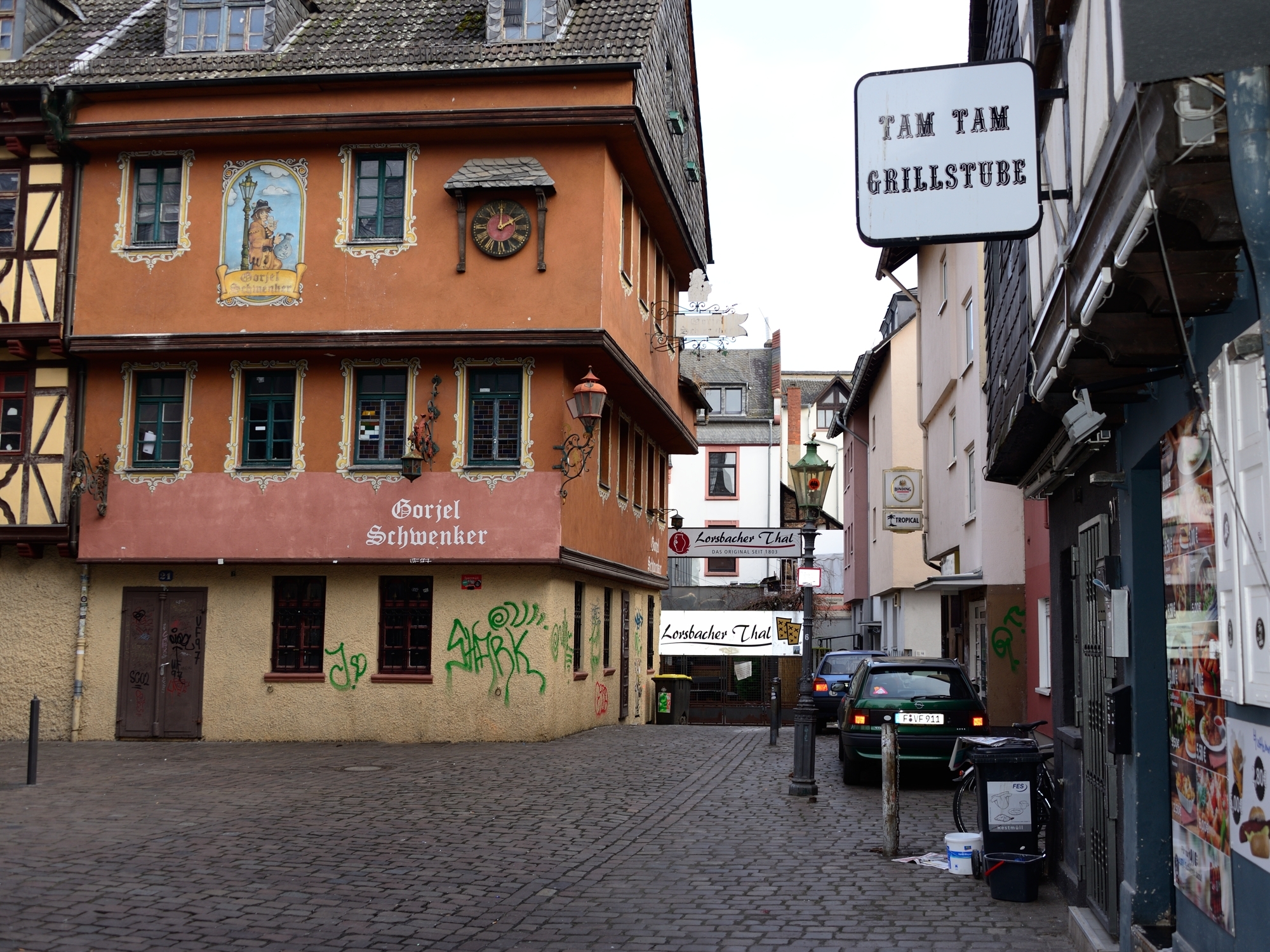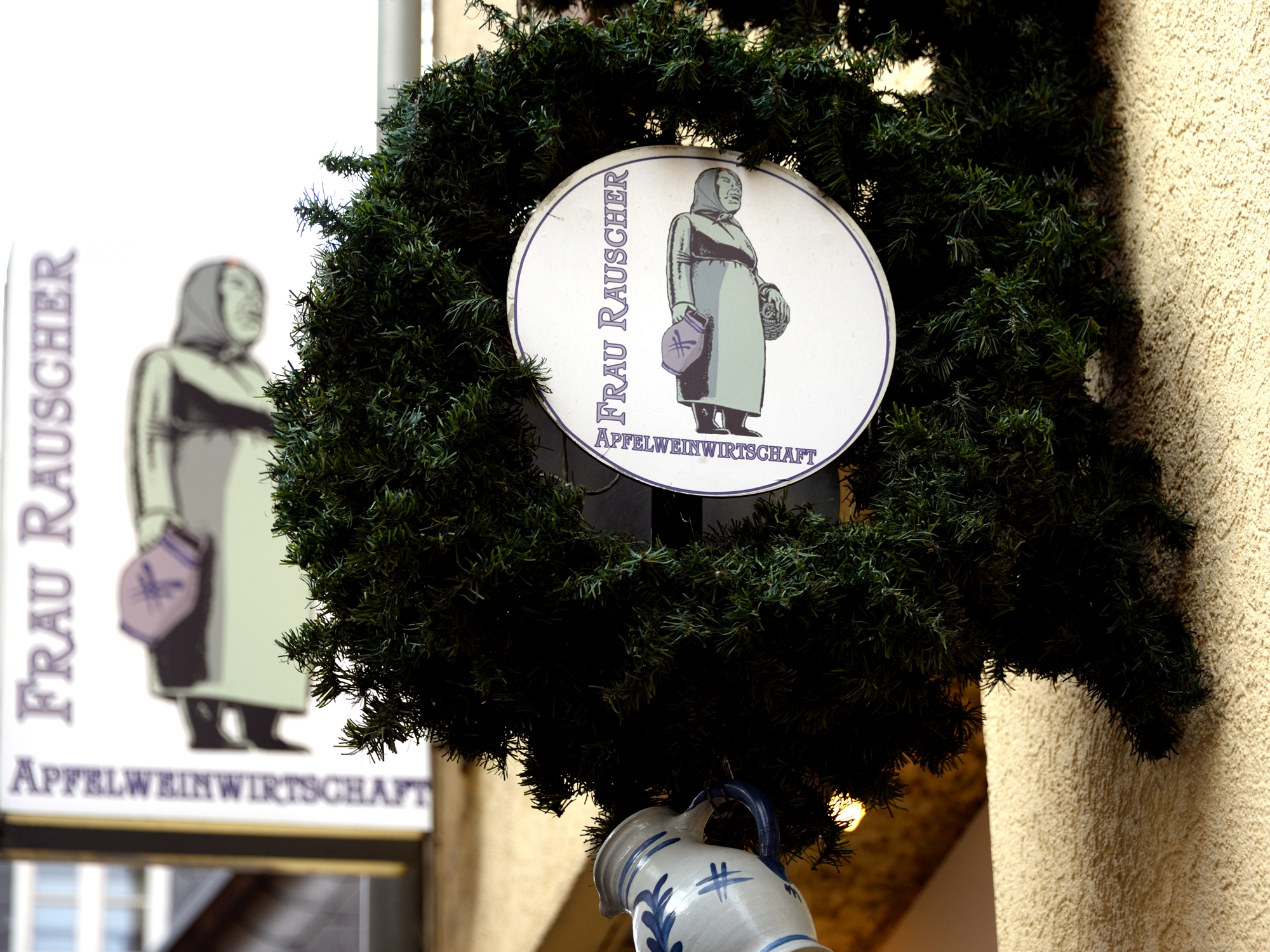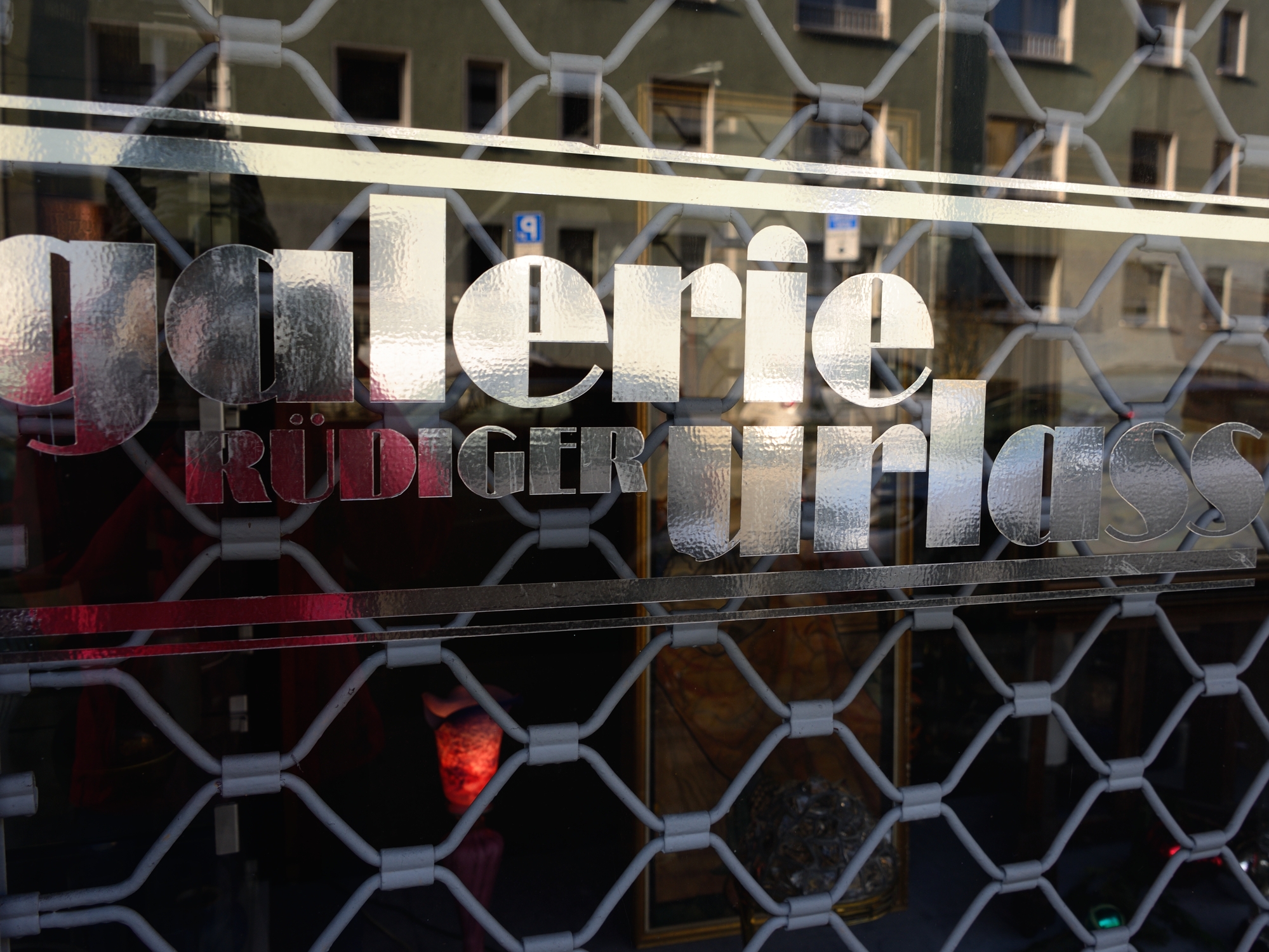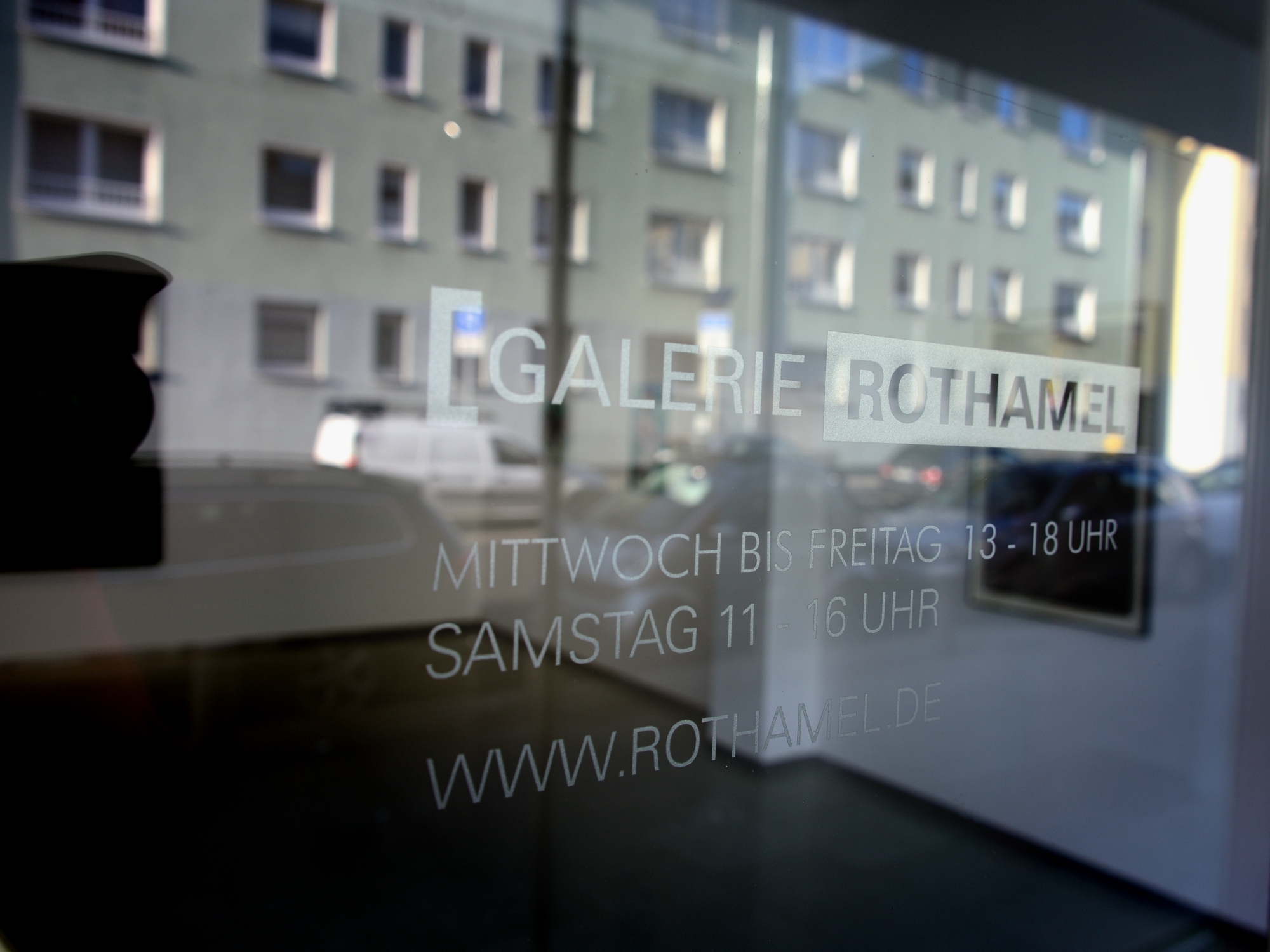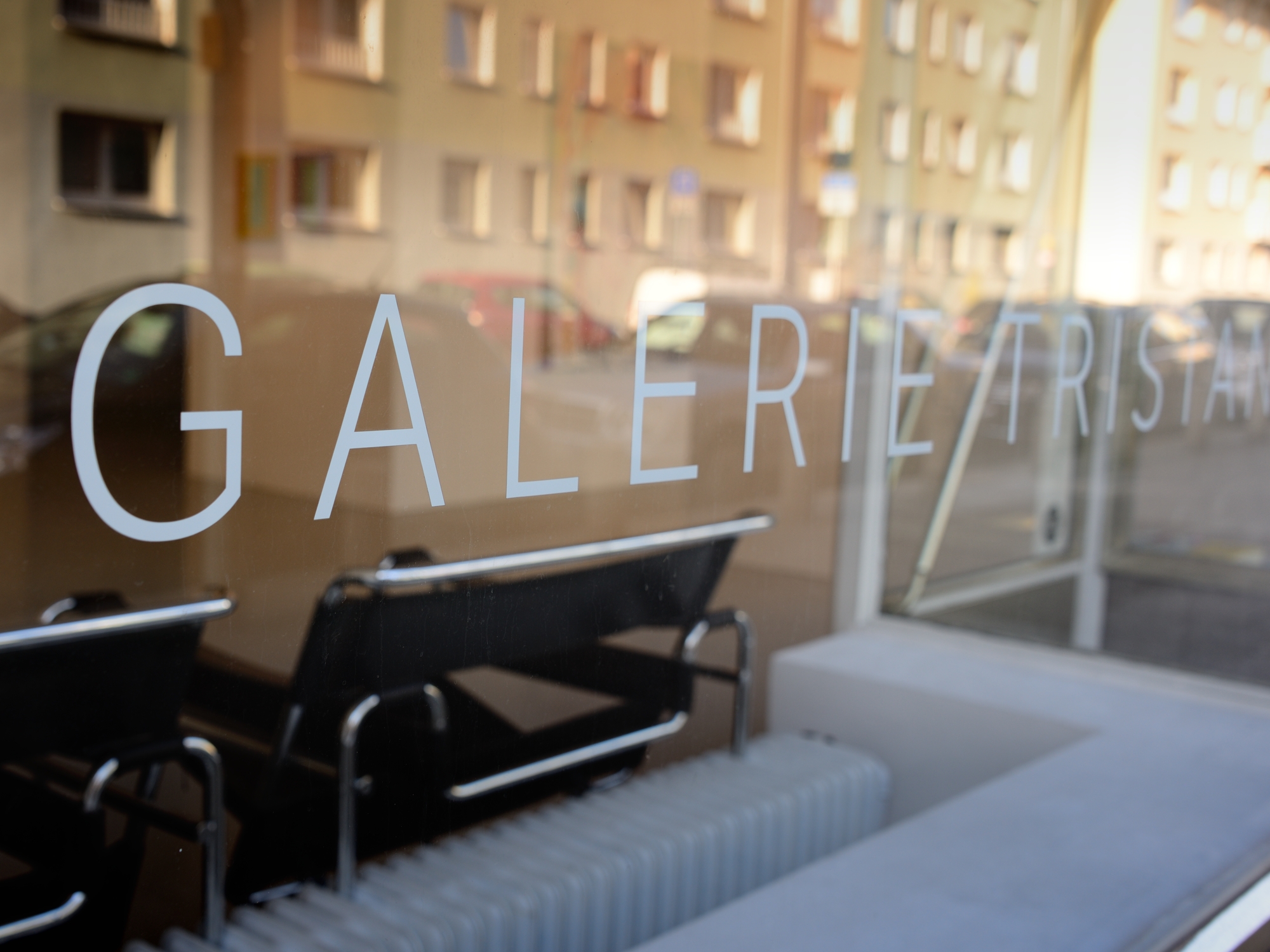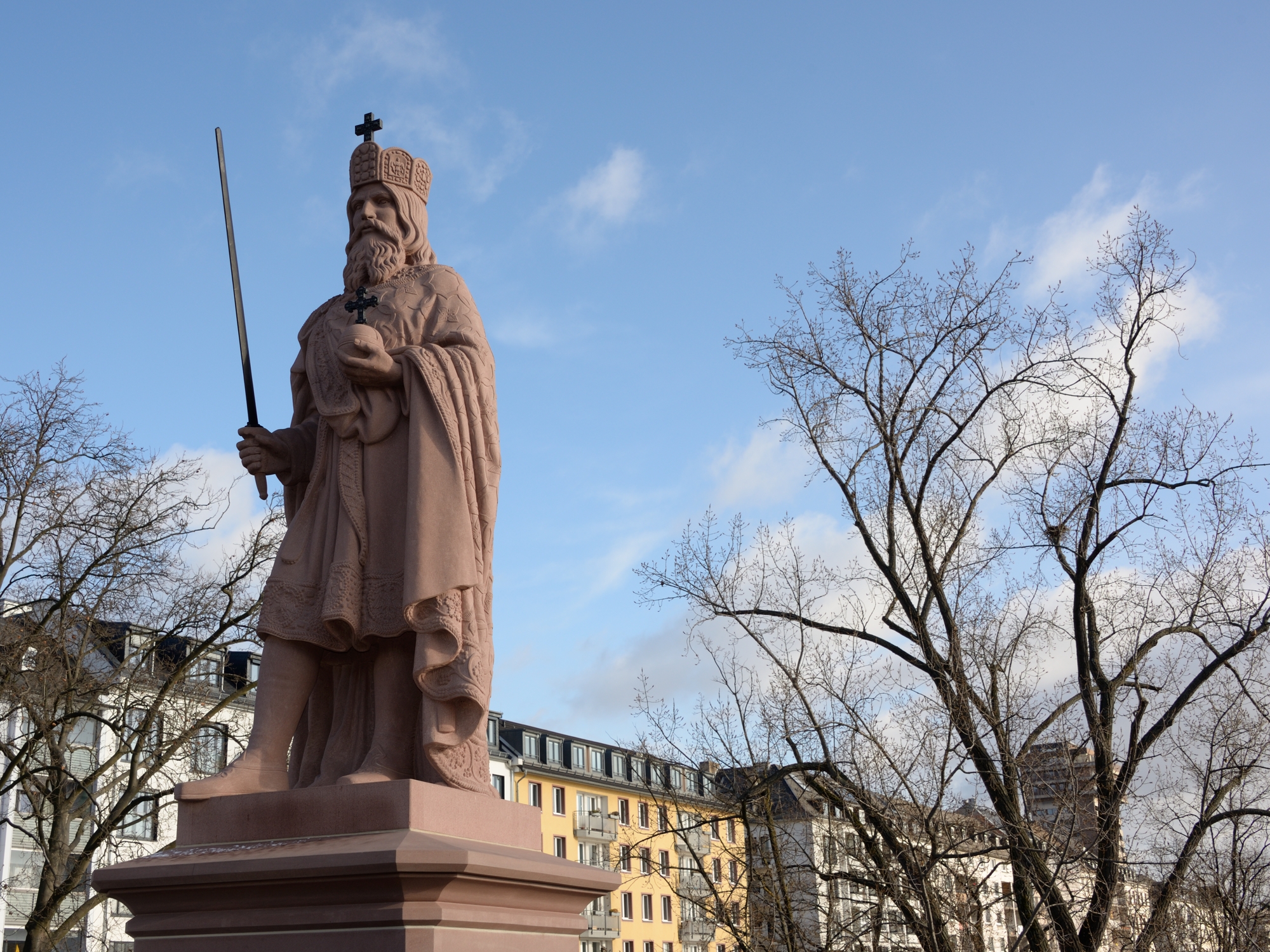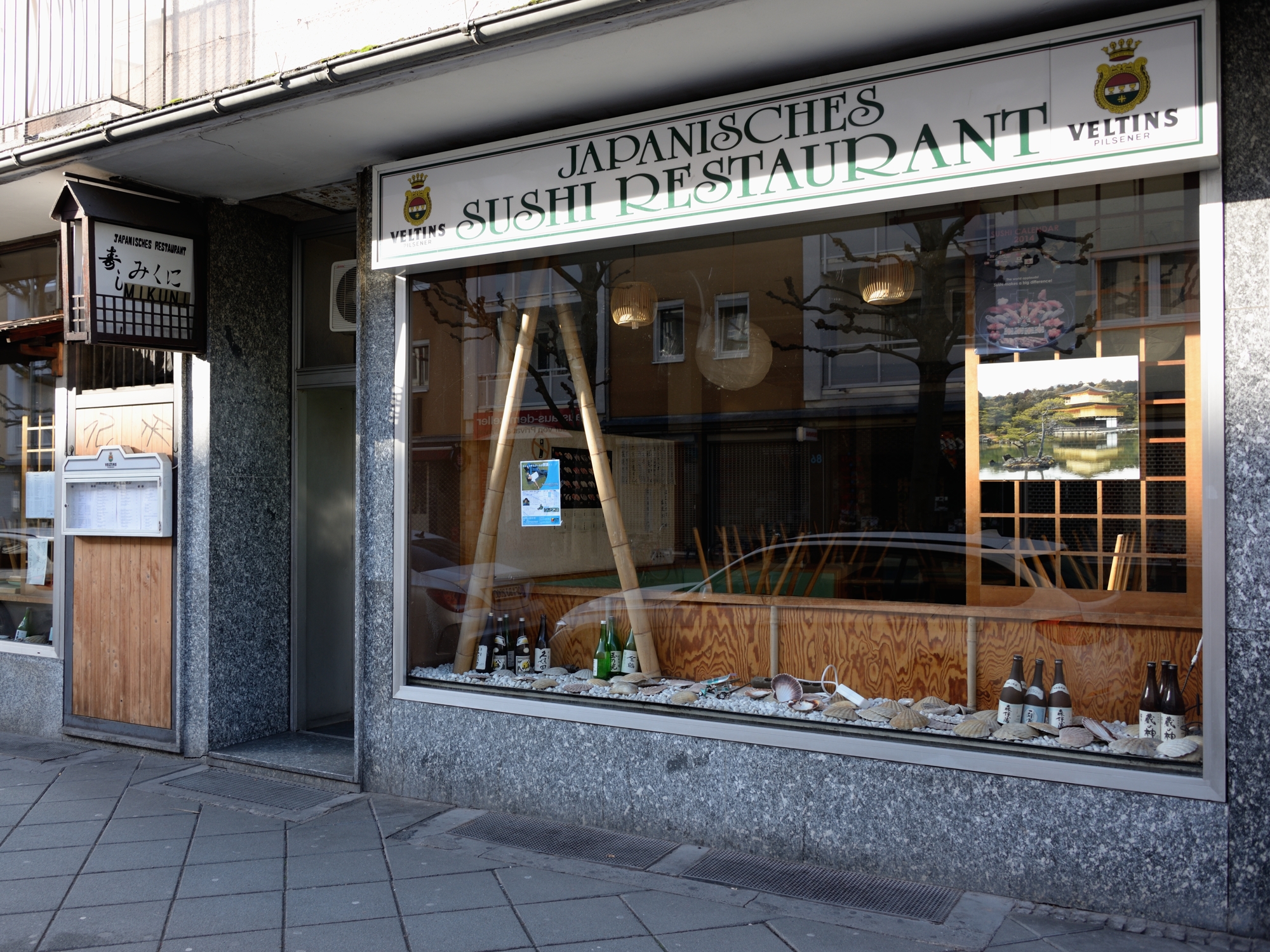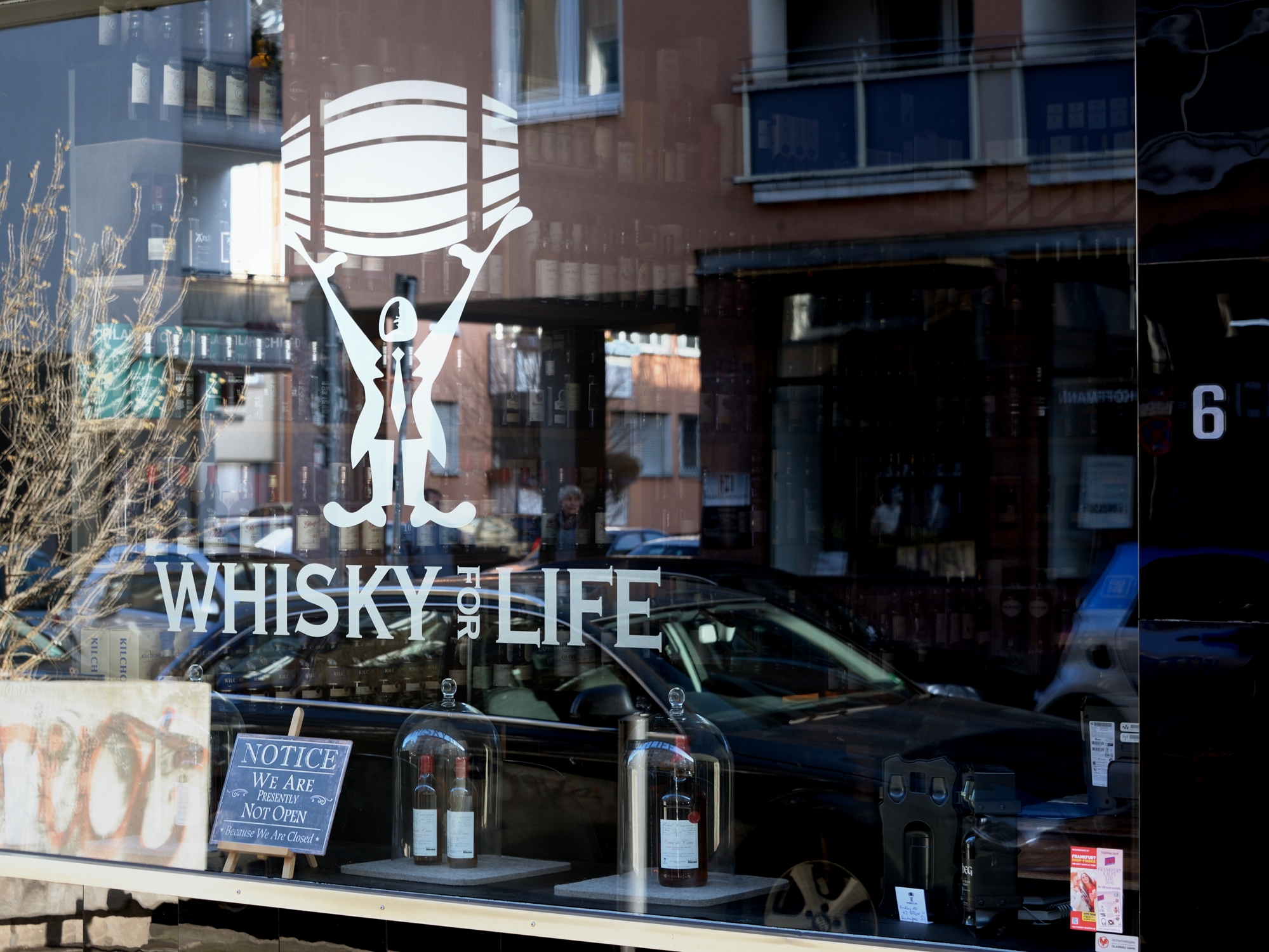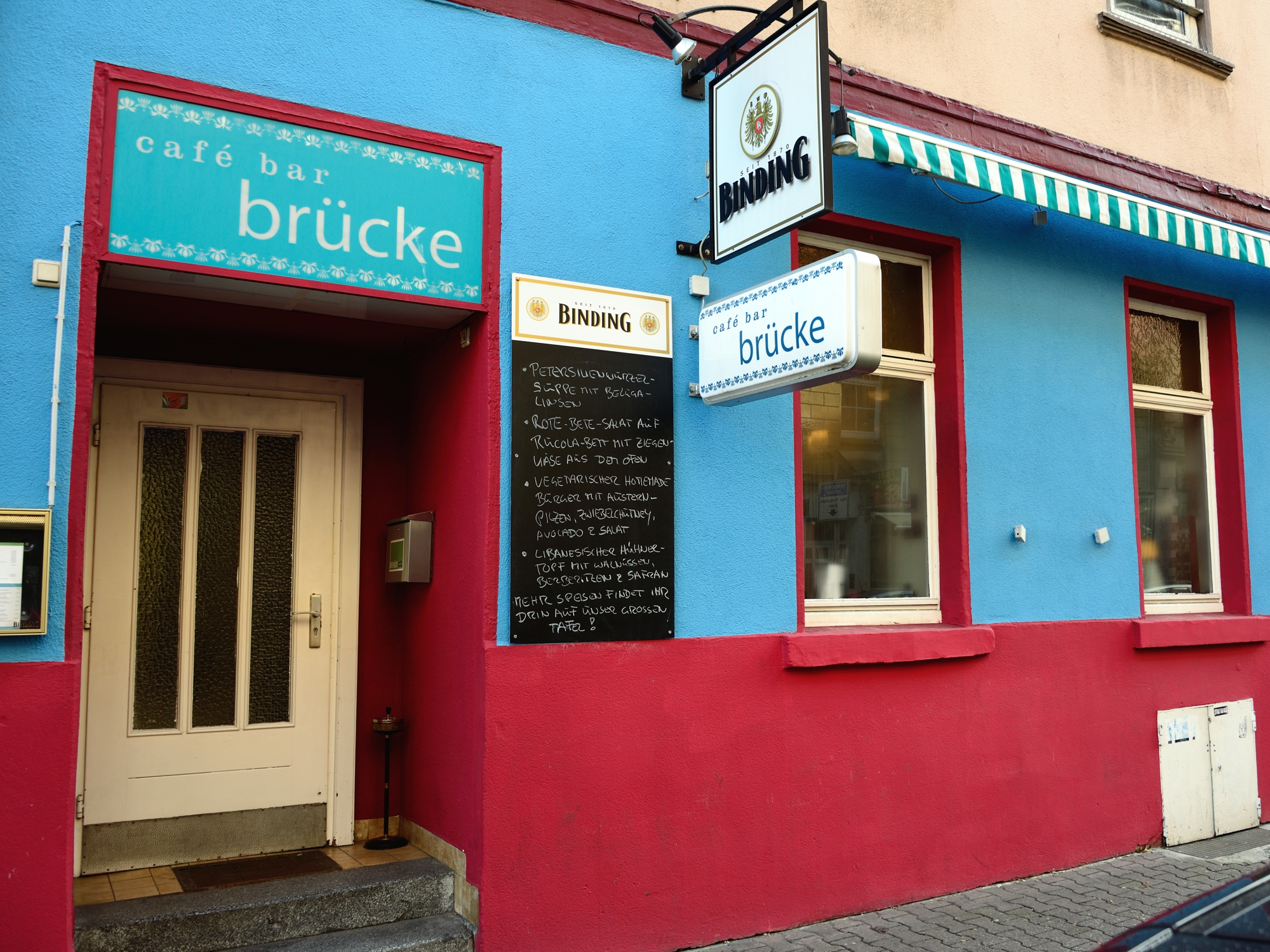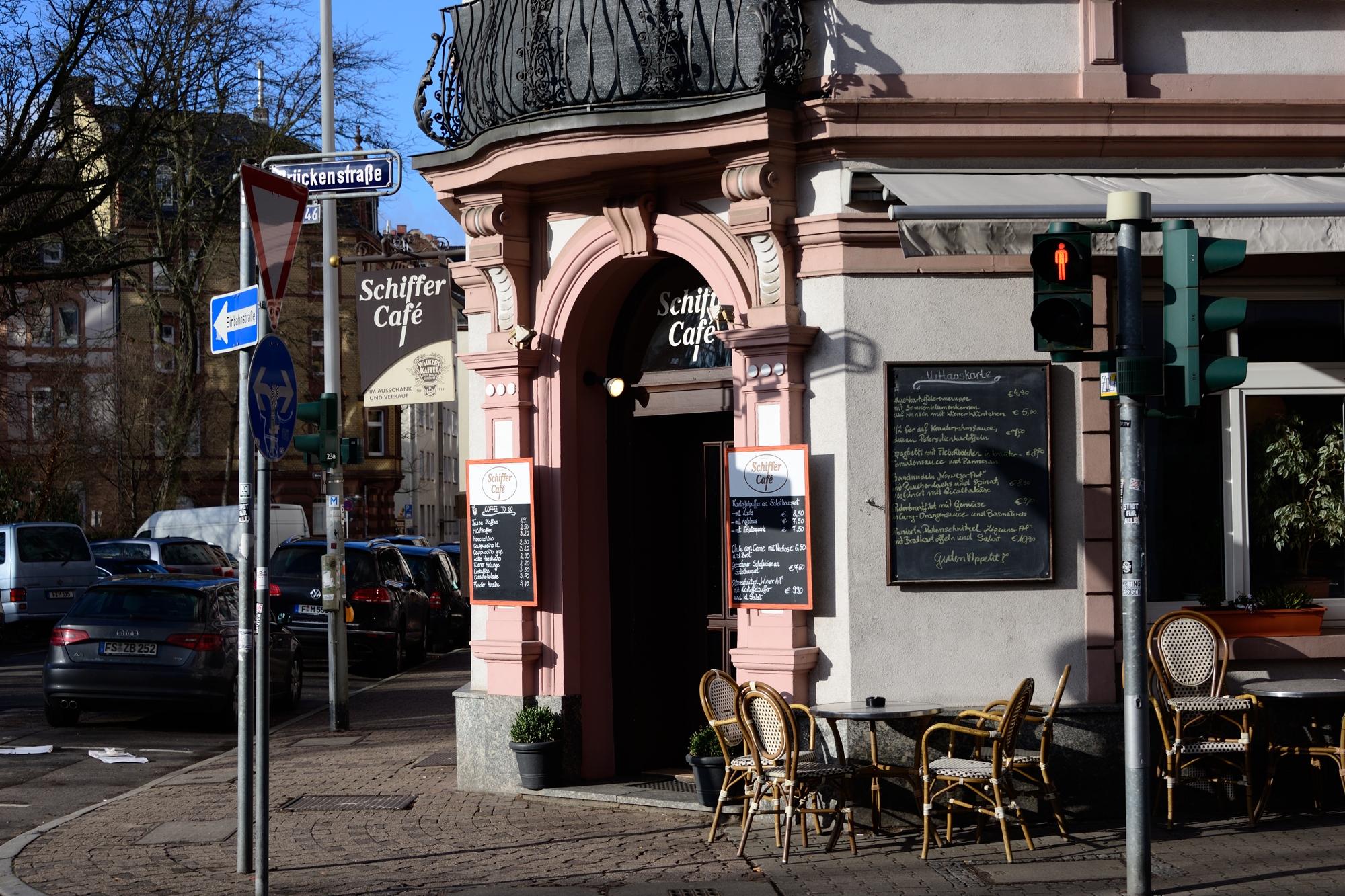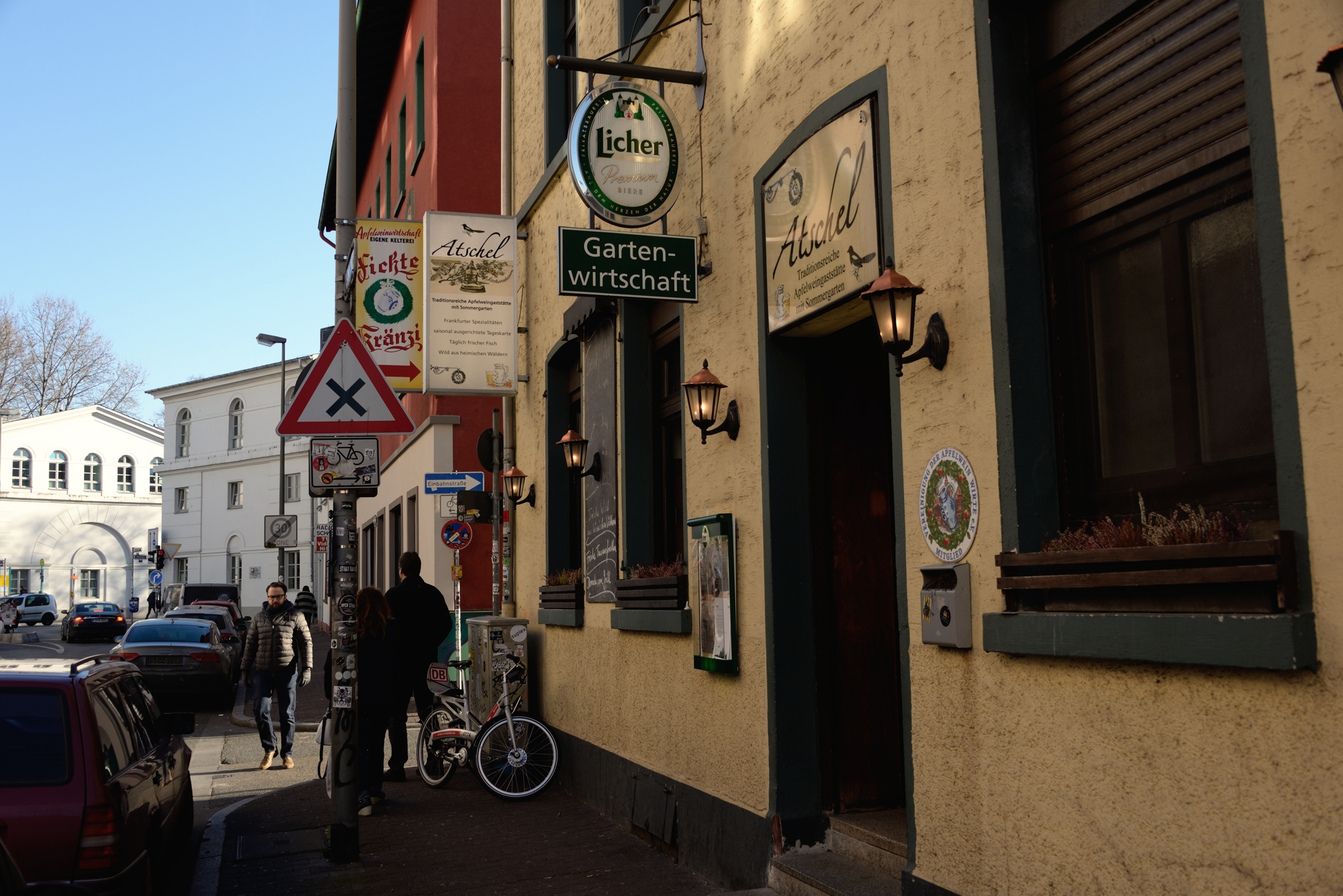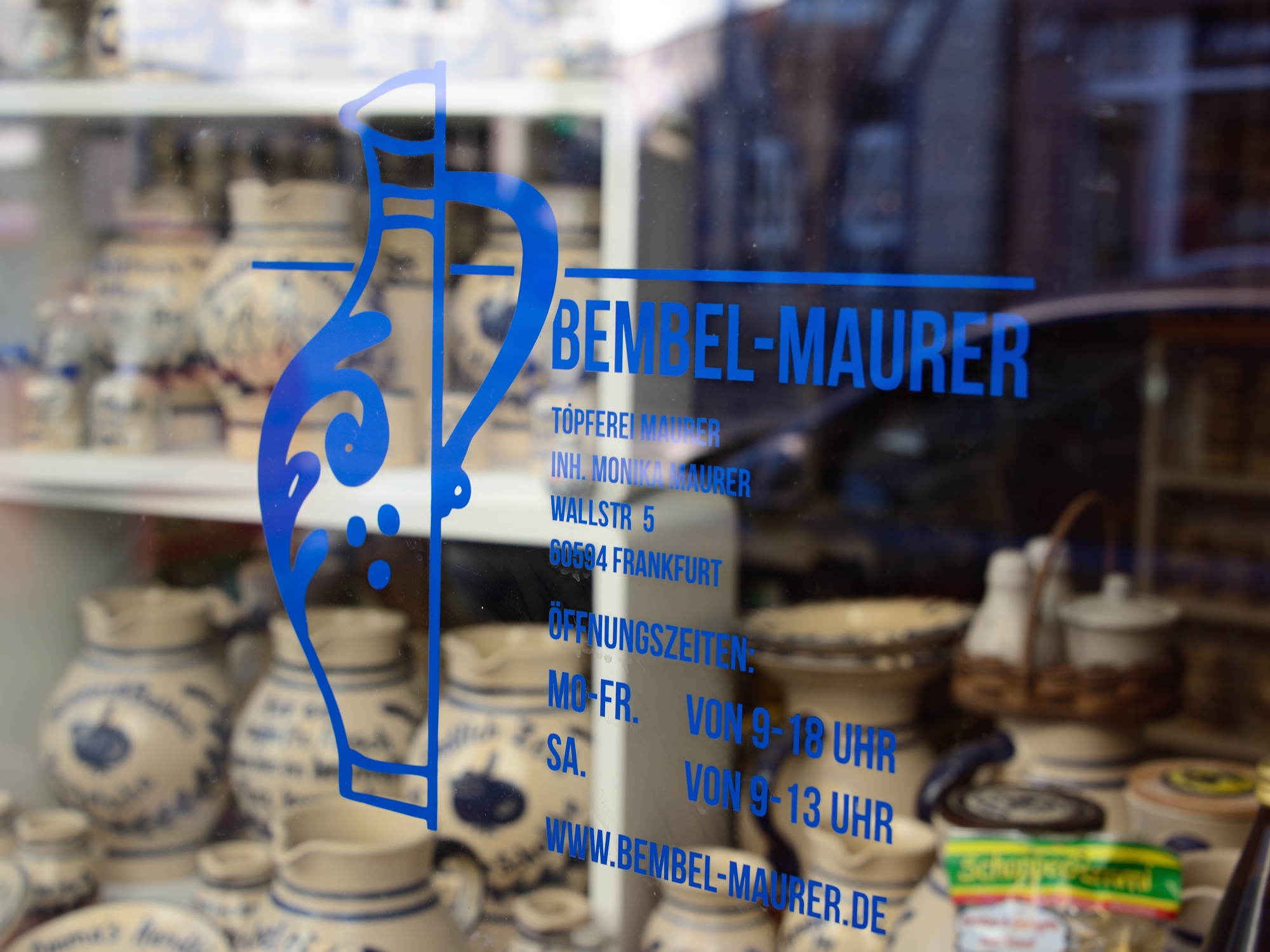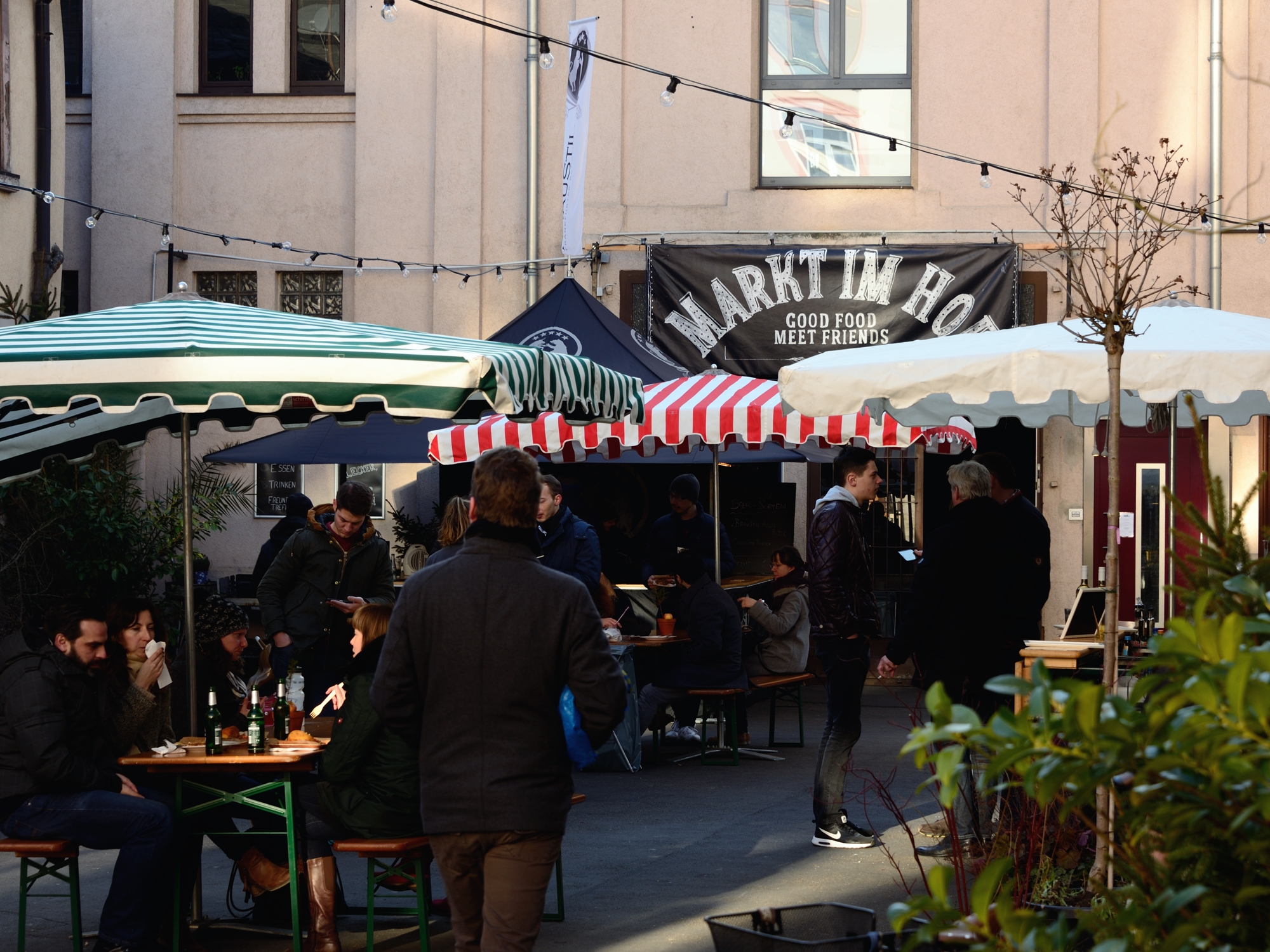Festivals in and around Frankfurt during Summer 2019
A list of (mainly wine) festivals local to Frankfurt, sorted by date from July to October.
As you can imagine festivals are very much about food and drink, but some are dedicated to the local Rheingau wine. Whatever the festival there will always be plenty of food, plenty of drink and live music to dance away the warm summer evenings to.
In this list, festivals are listed by date and every festival is either in Frankfurt or is easily accessed by public transport. I've added a few notes about trains, but please check the RMV website for full details. If you want to explore every regional wine festival this summer, then the Rheingau Wein Fest brochure is a must! An additional resource is the Weinwanderung website where you can search for vineyard walks by region.
Festivals in June - July
26 June - 7 July - Frankfurt Opera Square Fest, at the Alte Oper. Lots of food and drink stands, plus entertainment starting at lunchtime and into the evening.
4 - 8 July - Darmstadt Heinerfest, opens at 18:00 on July 4th. An amazing array of events and attractions during this 5 day festival hosted all around Friedensplatz, with a firework display on Monday evening. (Numerous regional and S-bahns depart Frankfurt Hauptbahnhof on a regular basis)
5 - 8 July - Eltville Sekt & Biedermeier Festival, This is a lovely festival along the Rhein promenade at Eltville, celebrating the sparkling wine of the region. The link also contains details of all other wine festivals in the Rheingau region. (RB10 regional train departs Frankfurt Hauptbahnhof every hour)
6 - 15 July - Frankfurt Höchst Altstadt Fest. Taking place at the Schloss and Justinusplatz. Daily from 1pm - midnight. Lots for the family to enjoy (S1 & S2 departs Frankfurt Hauptbahnhof regularly throughout the week)
12 - 15 July - Wiesbaden Schierstein Harbour Fest, Wiesbaden-Ost. A festival along the Habour promenade with plenty of music, food and drinks. On Saturday morning there is a flea-market, and throughout the weekend a dragon boat regatta. (Wiesbaden-Ost is the closest station. S1, S8, S9 depart Frankfurt Hauptbahnhof every 15 min)
12 - 15 July - Hochheimer Wine Fest, hosted in the old town of Hochheim. A chance to try Queen Victoria's favourite wine! (S1 departs Frankfurt Hauptbahnhof every 15 min throughout the week)
19 - 21 July - Frankfurt Christopher Street Day, Frankfurt. The main parade is on Saturday starting at Römerberg. Festivities all weekend long around Grosse Friedberger Strasse.
19 - 22 July - Geisenheimer Lindenfest. A wine festival hosted in the Geisenheim cathedral square and special opening of shops on Sunday 16th too. (Regional RB10 departs Frankfurt Hauptbahnhof for Geisenheim Bahnhof every hour throughout the week)
19 July - 4 Aug - Frankfurt Sommerwerft Theatre Fest - along the northern banks, near Weselerwerft, of the Main river a festival of theatre and events for all the family. Of course they'll be drinks and food too!
20 - 21 July - Amazing Thailand Fest, Bad Homburg. A weekend of Thai celebrations, arts and food, hosted in the the Kurpark. (S5 departs Frankfurt Hauptbahnhof every 15 min on weekdays, every 30 mins at the weekend)
26 - 28 July - Mainz Light Fest All along the Rheinufer you will find food and drink stalls as you enjoy the festival of lights. Special ships are chartered to view the lights from the river and there is a spectacular firework and laser show on the Saturday evening. (S8 departs Frankfurt Hauptbahnhof every 30 min throughout the week)
26 - 29 July - Frauensteiner Weinfest, Wiesbaden. Hosted on St. Georg and Katharina Platz, Georg Str. 2 in the centre of Wiesbaden. (Wiesbaden Hauptbahnhof is the closest station. S1, S8, S9 depart Frankfurt Hauptbahnhof every 15 min)
26 Jul - 4 Aug - Dietzenbach Wine Fest Taking place on Europaplatz in the heart of Dietzenbach this festival draws vintners from around the region. Lots of live music. Opens at 5pm every day. (S2 departs Frankfurt Hauptbahnhof every 15 min on weekdays, every 30 mins at the weekend)
Festivals in August
Until 4 Aug - Dietzenbach Wine Fest Taking place on Europaplatz in the heart of Dietzenbach this festival draws vintners from around the region. Lots of live music. Opens at 5pm every day. (S2 departs Frankfurt Hauptbahnhof every 15 min on weekdays, every 30 mins at the weekend)
Until 4 Aug - Frankfurt Sommerwerft Theatre Fest - along the northern banks, near Weselerwerft, of the Main river a festival of theatre and events for all the family. Of course they'll be drinks and food too!
2 - 4 Aug - Frankfurt Street Food Fest hosted at Hauptwache in the centre of the city, pretty hard to miss! Great selection of foods and drinks. (Numerous S-Bahns and U-Bahns travel through Hauptwache every minute of the day)
2 - 4 Aug - Oberursel Weinfest hosted on the Marktplatz. (S5 departs Frankfurt Hauptbahnhof every 15 min on weekdays, every 30 mins at the weekend)
2 - 4 Aug - Wallufer Weindorf A wine festival in the oldest wine producing village of the Rheingau. Hosted along the river bank at La-Londe-Platz, Walluf. (Regional RB10 departs Frankfurt Hauptbahnhof every hour throughout the week)
2 - 5 Aug - Frankfurt Main River Fest Hosted along the northern bank of the Main River, by the Eisener Steg in the heart of the old town. Funfair rides and lots of fun for the family. Firework display on Monday (7th) night.
3 -4 Aug - Kronberg Art and Wine Fest. A weekend of festivities starting at 3pm on Saturday until 8pm and Sunday from 11am - 7pm. Stores are open on Sunday too! (S4 to Kronberg departs Frankfurt Hauptbahnhof every 30 min throughout the week)
9 - 11 Aug - Frankfurt Main-Matsuri Fest. The 2nd Main-Matsuri Fest in Frankfurt, hosted on the Walther-von-Cronberg Platz in Sachsenhausen. Full program details are in the link.
9 - 18 Aug - Frankfurt Applewine Fest. A celebration of apple wine takes place on Roßmarkt with multiple producers selling many varieties of apple wine. This blog post offers a guide to the apple wine varieties.
9 - 18 Aug - The Rheingauer Weinfest in Wiesbaden One of the largest wine festivals in the World which takes place at Wiesbaden’s Schlossplatz and Dern’sches Gelände. (Wiesbaden Hauptbahnhof is the closest station. S1, S8, S9 depart Frankfurt Hauptbahnhof every 15 min)
11 Aug - Tomaten Fest at Gärtnerei Schecker, in Oberrad. Buy tomatoes by the basket full and snack on tomato based fare all around this wonderful hof. (The roads get very busy , so it’s best to cycle or take the tram to Wiener Str. and walk up)
15 Aug - Frankfurt Bahnhofsviertalnacht starting at 7pm. Roads are closed and the Bahnhofsviertal streets are handed over to the people of Frankfurt - drinks, food and music into the early hours.
16 - 18 Aug - Frankfurt 529th Fountain Festival in Sachsenhausen. A festival in old Sachsenhausen, celebrating the purity of the old water fountains. Yes, it has live music, food, drinks and a party atmosphere all weekend.
17 - 18 Aug - Frankfurt Bockenheim Weinfest, Weingarten, Bockenheim. Go along to Bockenheim and support their 3rd wine festival!
23 - 25 Aug - Frankfurt Museumsuferfest starting at 3pm on Friday and finishing with fireworks on Sunday night. Stalls of arts, crafts and old books along the Museumsufer. Whilst on the riverside on both the north and south side of the Main river are music, food and drink booths.
28 Aug - 6 Sept - Frankfurt Rheingauer Weinfest A wine festival hosting a huge variety of Rheingau wine producers along the Fressgass' (Große Bockenheimer Straße). This link offers a quick guide to German wine!
30 Aug - 1 Sept - Day of the open wine cellars in Rheingau. On these days, during September, vintners open the doors to their cellars and host special tastings and events. The link above lists the individual vintners and vineyards that are taking part. The event is repeated the following weekend on the 6th & 7th of September.
31 Aug - Frankfurt Deutschherrnfest. Along the Deutchherrnufer in Sachsenhausen from 3pm - 10pm. It s a day of fun for the family and entertainment into the evening. (Trams nr. 14 & 18 to Frankensteiner Platz)
Festivals in September
Until 6 Sept - Frankfurt Rheingauer Weinfest A wine festival hosting a huge variety of Rheingau wine producers along the Fressgass' (Große Bockenheimer Straße).
Until 1 Sept - Day of the open wine cellars in Rheingau. On these days, during September, vintners open the doors to their cellars and host special tastings and events. The link above lists the individual vintners and vineyards that are taking part. The event is repeated the following weekend on the 6th & 7th of September.
6 - 7 Sept - Day of the open wine cellars in Rheingau. On these days, during September, vintners open the doors to their cellars and host special tastings and events. The link above lists the individual vintners and vineyards that are taking part.
6 - 8 Sept Gartenfest Schloss Wolfsgarten, Langen. A must for gardening enthusiasts. Entrance fee applies.
6 - 15 Sept - Autumn Dippemess, Frankfurt Ratsweg. Fair rides and fun for all the family, starting 2pm. (Take the U7 to Eissporthalle.)
7 Sept - Frankfurt Brücken.Wall Fest. A festival celebrating the shops, market, restaurant and bars on Brückenstraße and Wallstraße in Sachsenhausen.
13 - 15 Sept Wine Market, Seligenstadt. Starting on Friday evening, throughout the weekend the old town is beautifully lit up in celebration of the wine fest. (Trains depart from Frankfurt Hauptbahnhof and Südbahnhof. you might need to change trains at Hanau, although there are direct trains too)
13 - 15 Sept - Rumpenheimer Kunsttage. Rumpenheim has a community of artists who throw open their doors to visitors. It's a great weekend centred around the Rumpenheim Schloss (Travel requires a car or a bike, or a 3km walk across pretty countryside from Arthur-von-Weinberg-Steg (Tram nr. 11)
14 - 15 Sept - Weinfest am Morschberg, Geisenheim Local vintners offer samples of their Geisenheim wines. (Regional RB10 departs Frankfurt Hauptbahnhof for Geisenheim Bahnhof every hour throughout the week and the footpath to Morschberg is well signposted (approx 20-30 minute walk)
19 - 21 Sept Frankfurt Harvest Festival, on Roßmarkt. From 10am - 8pm. Lots for the family to enjoy, and of course some food and drink!
Festivals in October
3 Oct - Schlemmerwanderung, Oppenheim A little further out than some other festivals, but still accessible by train.
11 - 14 Oct - Autumn Market & Fest (Herbstfest), Idstein Starting on the Friday through to Monday, hosted on Schlossplatz in the heart of this pretty old town. A family occasion plus musical entertainment. (The RB22 runs hourly from Frankfurt Hauptbahnhof to Idstein, every 2 hours on Sunday)
12 - 13 Oct - Elisabethmarkt & Fest, Marburg. A pretty university town about 80km north of Frankfurt. Not only the market, but also Sunday opening for stores in the centre too. (Regional RB and IC trains run half hourly from Frankfurt Hauptbahnhof to Marburg throughout the weekend. Buy a Hessen card, 35€, and up to five people can travel together)
13 Oct - Harvest Festival, Bad Homburg. The Harvest festival is hosted along Louisastraße and stores will be open from 1pm until 6pm (S5 departs Frankfurt Hauptbahnhof every 15 min on weekdays, every 30 mins at the weekend)
18 - 20 Oct - Federweisser Days, Rüdesheim An opportunity to try the fresh new wine up from the local vintners. They'll be onion cake on sale too, to compliment the wine. Hosted over two weekends! (RB10 regional train departs Frankfurt Hauptbahnhof every hour)
25 - 27 Oct - Federweisser Days, Rüdesheim. The second weekend of the Federweisser Days. (RB10 regional train departs Frankfurt Hauptbahnhof every hour)
Enjoying German wines at the Rheingau Wine Festival
The Rheingau Weinfest, hosted on the Freßgass' in Frankfurt, is a great opportunity to familiarise yourself with classic German wines. Put any preconception of sweet wine out of your mind. Good German wine is a whole new World waiting to be appreciated, however the German wine classification can feel complicated to novices so, to get the most out of the wine festival, below are some hints and tips to launch you into your voyage of wine discovery.
Dry or Sweet
Trocken is the word to look for if you want a dry, crisp wine. If you find the wine too crisp and minerally you might want to try a halbtrocken or feinherb wine which contains a small amount of residual sweetness, but are not sweet wines! Lusciously sweet wines, the ones you associated with dessert wines, carry the labels Auslese, Beerenauslese, Eiswein or Trockenbeerenauslese.
Trocken and feinherb labels. Photograph © Anne Noble
Grape Varieties
The Rheingau is renown for it's riesling, the king of grape varieties. Many people underestimate riesling however Masters of Wine highly rate it for it's complexity and amazing ageing qualities. Gently sniff the bouquet of your riesling and you'll be amazed at the variety of scents ranging from floral, fruit, honey, herbs and the very distinct 'petrol' nose of an aged riesling. The Rheingau offers some other grape varieties which might be more familiar once you recognise their English names: Grauburgunder = Pinot Gris and Weissburgunder = Pinot Blanc. If you have the chance also try a Scheurebe a truely unique German grape created in 1916 by Dr. Scheu. He combined two grape varieties, riesling and bukettraube (of silvaner heritage) resulting in a wine which is dry with gentle fruit overtones.
Spätburgunder, aka Pinot Noir, dominates red wine production in the Rheingau. The style produced varies from a light finesse, which reflects the cool climes of the Rheingau area, to a richer, darker wine from grapes nurtured in the vineyards using select harvests. The difference is easy to spot in the glass, a light transparent red wine of the old style and a rich deep red of the new style.
VDP
Some producers belong to the elite VDP association. VDP (Verband deutscher Prädikatsweingüter) started in 1910 and serves to promote quality viticulture focussed on regional grape designation, quality production and vineyard management working in harmony with nature. Wine producers have to meet with strict requirements before they can carry the VDP eagle on their bottles. There are a few VDP producers at the Rheingau Weinfest. One repeat visitor is F. B Schönleber and Weingut Hamm is another renown producer which has also achieved the organic certification.
VDP Eagle. Photograph © Anne Noble
Wine Stands
This is a list of this years participants, and all offer great quality wines. All along the Freßgass will be the wine stands interspersed with food stalls making it a great place to head for an evening out with friends.
Walking around old Sachsenhausen (Alt Sachsenhausen)
Old Sachsenhausen, south of the river, is a unique part of Frankfurt. Today the area comes alive at night, crammed as it is with bars, clubs and apple wine taverns but take a closer look and you will notice traditional cobbled streets, gas lamps and old medieval houses.
Große Rittergasse, Sachsenhausen in Frankfurt
First mentioned in a document back in the 12th century, old Sachsenhausen became the place where the fishermen, weavers, and the other poorer classes lived. The area survived the devastation of the second war and today offers a glimpse into the Frankfurt of old.
The easiest way to get to old Sachsenhausen is to walk cross the Alte Brücke (notes on other routes are at the bottom of this page). Once on the south side of the river, look in the direction of 10 o'clock and you'll see a side street (Große Rittergasse) running behind the youth hostel. Follow the side street and you'll suddenly find yourself standing next to the Kuhhirtenturm, the cowherds tower. Today it serves as a museum dedicated to the composer Hindemith, who converted the tower into accommodation and whose family lived here from 1923 until 1943. Only open on Sundays, it a great little museum offering information in English and German. The link above offers more details.
Kuhhirtenturm, now a museum to the composer Hindemith, open on Sundays.
Wander along Große Rittergasse. Many of the bars and building you see are old timber frame houses but the facades were covered over in a post war attempt to modernise the rickety old buildings. At the junction of Frankensteiner Straße stands one of many traditional water fountains you can find around old Sachsenhausen. These pink sandstone pillars, decorated on top with statues of people, animals and, in one case, even an artichoke were meticulously restored by Georg Krämer in the 1950/60s. Every year since 1490 the local folk of Sachsenhausen host a fest (during the 3rd weekend in August) to celebrate the fountains and their vital source of water.
If you are in the mood for a coffee stop by the Libertine cafe which offers home-made cakes in the afternoon. It also offers breakfast and in the evening the cafe becomes a trendy bar!
Next, wander up the cobbled lane of Kleine Rittergasse. If you're here in the evening stop by the street lamps and take a close look. Many of these old lamps are still lit by gas, if you're not sure whether it's a genuine old lamp or not, have a listen and you'll hear the gentle hiss of gas. Near the top of Kleine Rittergasse, turn left into what looks like a dead end. Ahead of you is the back entrance to "Lorsbacher Thal" one of the traditional apple wine taverns, with a good reputation too. An idea place to stop and enjoy traditional fare such as Handkäse, grüne Söße and of course, apple wine.
Never heard of apple wine? More information is available on my apple wine blog post, but back to the business of old Sachsenhausen...
From the back entrance of the Lorsbach Thal, you can turn the corner and head left onto Klappergasse. More old houses and gas lamps, but this lane is particularly famous for it's statue dedicated to Frau Rauscher, who spits water at unsuspecting passers-by. She was a local character, known for drinking a little too much apple wine and even has a poem dedicated to her antics, this English version isn't a direct translation but works well as a rhyme: Mrs Rauscher’s been found with a bump on her head. Whether from apple wine or her old man, at least she ain’t dead.
Summa Summarum, a great little live band venue and jazz club deep in the cellar of this old 17th century building
Wander back up Klappergasse and keep your eyes open for brass apples in the cobble stones which are a nod to the apple wine heritage of the area. At the end of the street join Kleine Rittergasse and walk towards Paradiesgasse. Turn left and in 30 metres turn left again onto Neue Wall. Here you find more apple wine taverns, the two best being Klaane Sachsenhäuser with it's lovely courtyard and Daheim in der Affentor Schänke. Alternatively, turn right and cross over the road into Wallstraße for the opportunity to explore more of Sachsenhausen as detailed in my other blog post, Konstablerwache to Sachsenhausen.
Brass apple depicting the trail through old sachsenhausen
Map and directions
Alt Sachsenhausen
A larger map detailing highlights of this blog is linked here. To get to old Sachsenhausen using public transport, take tram number 14 or 18 and alight at Frankensteiner Platz, or take the S-bahn or U-bahn to Südbahnhof and exit via Diesterwegplatz.
If you are in the area, don't forget the flea market, held every fortnight on a Saturday along the Museumsufer. Click on this link for up to date information.
The Museumsufer, which runs along the south bank of the river Main, offers plenty of museums to visit. This museums link will tell you more.
Frankfurt: from Konstablerwache to Sachsenhausen
January, February and March are cold months in Frankfurt. Even so it's still possible to explore and, by browsing a shop or two or enjoying a new cafe, you get the chance to intermittently warm up. The walk I'm suggesting for such a Winter's day takes you into what appears to be an unassuming part of town, filled with 1950's post war architecture but delivering some lovely cafes, galleries and views which you might otherwise never notice. The walk is simply a straight line from north to south and over the river.
Starting at Konstablerwache, if it's Thursday or Saturday you have the chance to peruse the farmers market, eat a bratwurst and have a glass of Glühwein from one of the wine stalls. From Konstablerwache head south, down Fahrgasse.
Fahrgasse, starting at Konstablerwache in the heart of Frankfurt
Within 100 metres, you'll notice a large wall on the left hand side of the street. It's a fragment of the old medieval wall from the 12th century, the Staufenmauer. It also served as the northern entrance to the Jewish Ghetto, the Judengasse, decreed in 1462 and the first Jewish ghetto in Europe. Destroyed in the late 1800's, nothing remains of the ghetto today.
An der Staufenmauer, at the junction of Fahrgasse and Töngesgasse
Carry on heading south and the first half of Fahrgasse has a variety of Asian stores and if it's lunch time you might want to stop by one of the authentic restaurants, e.g. Mikuni, and have a bite to eat. If you prefer a coffee then carry on down Fahrgasse, crossing over Berliner Strasse and towards the river. This half of Fahrgasse has antique shops and galleries on both sides of the street that are worth a browse.
Part way down the street, on the right hand side, is a small street called Weckmarkt. At the very entrance of this street is a modern jewellery store called "feinform" which offers some interesting contemporary pieces and is worth a peek. Back onto Fahrgasse and a little further south is a whiskey shop, Whiskey for Life which is every whiskey drinkers dream. If you're lucky you might catch a tasting. Opposite on the other side of the street is the Holy Cross Brewing Society, reputedly one of the best coffee stops in town. In fact, you're spoilt for choice for places to relax and eat in this area. Check out Cafe Sugar Mama , Naiv and Langosch.
If you're not quite ready for a stop then walk to the end of Fahrgasse and onto the Alte Brücke. As you step onto the bridge look to your left to see the fine statue of Karl der Grosse, aka Charlemagne. He was the King of the Frankish tribesmen and the first person to be crowned Holy Roman Emperor. He's also gave Frankfurt it's name which means, 'the ford of the Franks'. As you cross the bridge, take in the view of the ECB, European Central Bank on the left hand side and get your camera ready for the classic 'Skyline' view of Frankfurt to your right. Once over the river, keep to the left hand side of the bridge and at it's end, cross over the road (Sachsenhäuser Ufer) and head straight down the side street which is the beginning of Brückenstraße. Almost immediately you'll discover the entrance to the Ikonen Museum which has quite the collection of religious artefacts. Next door is the Deutschordenskirche. It's usually open by 12 noon, so step inside and take a look around. If it's January you're in for a special treat because the nativity scene is quite something to behold.
Ikonen Museum, Frankfurt.
From the church, continue down Brückenstraße, over the junction. You're now in the heart of Sachsenhausen. Immediately to your left is the Brücke Cafe, serving coffee, home-made cakes, drinks and meals late into the evening. Further down the street are clothing boutiques and plenty of stores for window shopping. One highlight is the Portuguese gourmet shop at number 60 - Casa de Portugal Here you can buy groceries, port, terracotta pots and freshly baked Portuguese specialities. It's a great little place. Down at this corner of Brückestraße is another great cafe, Schiller Cafe, serving breakfasts and meals all day.
Wander back up Brückestraße, and turn right (east) along Wallstraße. Again, this street hosts an array of independent shops, restaurants and in particular two classic apple wine taverns, Fichtekranzi and Atschel (Atschel is usually open at lunch time) Next door to Fichte Kranzi is a traditional pottery shop, Töpferei Maurer, selling all things pottery related to Frankfurt's apple wine scene. On Saturdays there is also Markt im Hof, a small venture hosting a couple of food trucks, apple wine tastings and an indoor canteen with innovative choices of food. It's a real favourite with the locals!
By now you've probably seen a few places where you'd like to stop, eat and relax. If you're still in the mood for exploring then look out for my next blog post which will take you across the road and into the heart of Old Sachsenhausen!
What to do on a winter's day in Frankfurt
Winters can be cold in Frankfurt and, although bright and crisp outside, it's only a matter of time before you hanker for somewhere indoors to keep yourself warm. Here are some ideas for the winter months.
Frankfurt cinemas screening films in English
Some cinemas in Frankfurt screen films in the original language, e.g. a British film in english or a French film in french, with German subtitles. Here are some recommendations for watching films in English.
Metropolis, close to the Eschenheimer Tor. Check their webpage for the up to date programme and look for films with the UK/USA flag and "screening in English" written next to it.
E-Kinos, at Hauptwache (near the Sparkasse). Original language screenings are usually on a Sunday or Monday. Scroll down the program and look for the screening times. If there is an "Original Version" screening then it will be shown at the bottom of the time list .
Mal Seh'n Kino, in Nordend on Adlerflychtstraße. Check the program; for English language films look directly under the title of the film for"englische OmU" or "amerikanische OmU" .
Harmonie cinema, in Sachsenhausen screens films in the original language on Mondays and, occasionally, on additional days. That means French films are screened in French, American films in English etc. Look out for UK/USA films and the words "Engl. OmU" which means "English with (German) subtitles."
Orfeos on Hamburgerallee occasionally screens films in the original language. An added bonus is the lovely restaurant which serves very good pre-screening dinners. To see which films are in English, check the programme for "engl. mit dt. Ut" meaning "English with German subtitles."
The English Theatre in Frankfurt
The English Theatre hosts some excellent productions. The theatre bar offers snacks and drinks and pre-ordering for interval drinks too. For post-theatre dining, Fundus on Willy-Brandt Platz stays open until midnight. This January and February 2017 the theatre is showing Spamalot. Check this link for dates, times and tickets.
Inside the Kaisersaal with it's 52 portraits of the Holy Roman Emperors
Frankfurt museums
Frankfurt's museums have regular visiting exhibits so there is always something new to see. This link offers more in-depth information on the entrance fees, a link to the official museums page and regular museum opening times (e.g. many museums are shut on a Monday). A few of the of the visiting exhibits are listed on my "Monthly events in Frankfurt" page,
City centre cultural excursions
Paulskirche on Paulsplatz is otherwise known as the "Cradle of German Democracy" it was in this building that the first Parliament was hosted in 1848. Today the church is open and free to the public and hosts a permanent exhibit. At the ground floor level text is offered in English, as well as German, and a mural by Johannes Grützke depicts, "The Path of the Representatives to St. Paul's Church." Upstairs hang the flags of the 16 states of Germany.
Attend an organ recital at the Kaiserdom (cathedral). The organ was installed in 1957 and is a spectacular instrument. Details of up and coming recitals are listed on the WALK-FRANKFURT, "Monthly events in Frankfurt" page.
Visit the Kaisersaal - The Imperial Hall displays 52 portraits of the Holy Roman Emperors from Charlemagne (Karl der Große) to Franz II. The entrance can been found on the southside of the Römer building, on Limpurgergasse. Enter through the iron gates and in the courtyard there is a machine where you pay your 2€ entrance fee. Walk up the spiral steps to enter the building. Once inside go up the next set of stairs into the Imperial Hall. Open between 10:00 - 13:00 and 14:00 - 17:00. Occasionally the Kaisersaal is closed due to private events.
Visit the Cloister (free entry) within the Institute for the History of Frankfurt, and hire an audio guide (2€) detailing the medieval frescos of Jörg Ratgeb. The institute also hosts free exhibits about Frankfurt upstairs. At present the exhibit details the development and maintenance of the Frankfurt Greenbelt.
Jörg Ratgeb frescos at the Carmelite Cloister, Institute for the History of Frankfurt
Go to the Zoo - even during the winter the Zoo is open everyday and has indoor houses as well as outdoor enclosures. Check the webpage for opening and closing times. Right now the Zoo is collecting old mobile phones to raise money for the mountain gorillas in the Congo - have a quick clear out and take your old mobile phone along!
Cafes
If you're in town then check out some of these cafes, listed in another blog post, in which to rest your weary legs and warm up with a coffee, tea or better still a hot chocolate.
--
Frankfurt café culture
When you arrive in a new town it's hard to avoid the large chain coffee houses and mediocre cafés, so here's a guide to some of the places the locals like. There's nothing fancy about these places, it's more about, "when in Frankfurt, do what the Frankfurters do"
Wacker's (Kornmarkt 9), closed on Sundays! This is top of the list for good coffee served in a way the Germans like it, strong! Wacker's has been roasting coffee since 1914. The shop is basic, with a small seating area indoors and a few tables and chairs outside. At busy periods, when all the seating is taken, locals spill over onto the other side of the street with their coffee cups and sit on the wall to enjoy a few minutes peace and quiet. Wacker's also sell a variety of cakes and individually wrapped chocolates to accompany your coffee.
Wacker's Coffee Shop - it's like stepping back into the 1950's
Bitter & Zart is also in the old town (Braubachstrasse 14) and offers the air of a 1920's tea and coffee salon. It's famed for it's hot chocolate which is thick, rich and unsweetened (I always laden mine with sugar and order it with whipped cream!) Bitter & Zart offers lunch time snacks as well as home-made cakes, of which one is usually gluten-free. Next door is their chocolate emporium which is also worth a browse.
Bitter & Zart, serving hot chocolate thick enough to stand a teaspoon in.
Naschmarkt am Dom (Domstraße 4) is very close to the cathedral entrance. It's small but offers a good variety of hot and cold drinks and the cakes are baked on the premises. Gluten-free options are also available.
Metropol Cafe am Dom (Weckmarkt 13) is on the south side of the cathedral. This laid back, Bohemian cafe, serves great breakfasts and gigantic pieces of home-made cake. It has a lovely garden which is a sun-trap and a great place to hang out in, with a glass of wine, during the in the summer months.
Tee-haus Ronnefeldt (My Zeil shopping mall, ground floor towards the back entrance) This is the place to go to if you love tea. Ronnefeldt has a long tradition in Frankfurt and has an incredibly large selection of teas to drink on the premises or to buy and take home with you.
Ronnefeldt Tee-Haus which can be found in the My Zeil Shopping mall
Manufactum brot&butter (Bockenheimer Anlage 49-50) closed on Sundays! This store, come cafe, is located close to the Old Opera House. The cafe is proud of it's artisan foods, freshly baked bread and even offers a glass of unpasteurised milk for those not enjoying a coffee, tea or glass of wine. There is plenty of indoor and outdoor seating and once you've finished snacking you have the chance to visit the Manufactum shop next door which is full of interesting artefacts to browse.
Frankfurt day trips - Lohrberg by bus or bike
Lohrberg is 7km north east from Frankfurt city centre and is accessible by bus, car or bike (travel details are at the end of this post). It offers one of the best views of the Frankfurt skyline but that's not it's only attraction, Lohrberg is also renown for it's vineyard and orchard. With two cafes offering local food and refreshment lots of Frankfurters head up to Lohrberg to enjoy a relaxing day and be at one with nature. It's free to wander around the orchard which is maintained and cultivated in harmony with the local wildlife. While you wander around you are certain to stumble across chickens, bee-hives and small garden plots offering information about how different habitats benefit different animal species.
View of Frankfurt skyline from Lohrberg (Photo copyright © by Anne Noble)
Having enjoyed the orchard, take time to relax with other visitors (many arriving on their bikes) at MainÄppelHaus, a small cafe selling apple juice produced from the orchard's apples. This Sunday, 18th September 2016, the MainÄppelHaus is hosting an Äpplerfest offering fun for all ages. If you have more of an appetite, head over to the Lohrberg-Schänke for a plate of traditional Frankfurt food and take in the skyline view while you eat.
Orchard at the MainÄppelHaus, Lohrberg (Photo copyright © by Anne Noble)
After Lohrberg head into Bad Vilbel, a town renown for it's mineral water. It's local Hassia brand appears on many a restaurant table across Germany. The Kurpark has lots of interesting features to explore and has a map to download listing the key sites to visit. In addition there is the Milano ice-cream parlour, to be found at Niddapl. 1, 61118 Bad Vilbel
Only a couple of kilometres further on from Bad Vilbel is Dottenfelderhof, a small organic farm open from Monday to Saturday. At the farm you can visit cows, pigs and chickens and afterwards relax for coffee and home-made cake at their cafe. On-site is a small shop, full of organic produce and, depending on the time of year, you might be lucky to "pick-your-own" flowers from one of the nearby meadows.
Piglets at the Dottenfelderhof, near Frankfurt (Photo copyright © by Anne Noble)
Getting there
Cyclists from Frankfurt can enjoy a lovely cycle heading out to Lohrberg and Bad Vibel by following the Nidda river from Frankfurt in an easterly direction. The river meanders through gentle country side and a special highlight on the way is the Tower Cafe at the old Bonames airfield.
By public transport, take bus 30 to the bus stop Heiligenstock, or bus 43 to the bus stop Budge-Heim and a short walk will bring you to Lohrberg. Both journeys are included in the Frankfurt travel zone. Be aware however, that Bad Vilbel is out the travel zone and a supplement will need to be paid.
There is a car park at Lohrberg with plenty of spaces on Friedrich-Heyer Weg.

